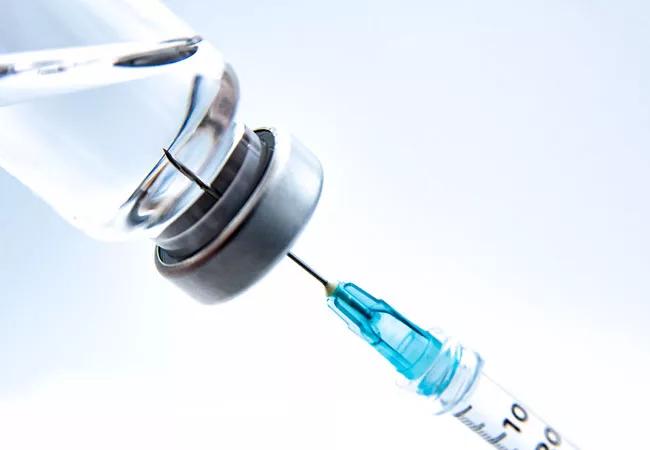Treatment with GnRH agonists may foster a return to menstruation

Many women receiving chemotherapy face the prospect of premature menopause because the drugs destroy ovarian follicles. Research led by authors from Cleveland Clinic is helping to unlock the keys to use of AMHR2BP, a peptide that mimics anti-Müllerian hormone (AMH), to preserve fertility in these patients.
Advertisement
Cleveland Clinic is a non-profit academic medical center. Advertising on our site helps support our mission. We do not endorse non-Cleveland Clinic products or services. Policy
Produced in granulosa cells (GCs) in ovarian follicles, AMH is known to be a marker of ovarian reserve. It prevents development of primordial follicles (PDFs) and controls recruitment of dominant follicles. In chemotherapy patients, treatment with gonadotropin-releasing hormone (GnRH) agonists can help maintain AMH concentrations and foster a return to menstruation.
But evidence is lacking on whether GnRH agonists are truly protective when it comes to fertility. That is where studies of recombinant AMH and the development of AMHR2BP by scientists at the Cleveland Clinic come in.
“The concept here is that if we provide AMH or an analog directly to patients undergoing chemotherapy, we may be able to prevent primordial follicles from entering the first developmental step,” says Laura Detti, MD, Chair of the Department of Subspecialty Care for Women’s Health. “That would safeguard their ovarian reserve until after their treatment is completed.”
A reproductive endocrinologist, Dr. Detti is first author of three recent studies aimed at exploring that hypothesis. One is an in vitro investigation of the impact of rAMH on granulosa cell replication, published in Reproductive Sciences in July. The other two—one in vitro and the other in vivo—are studies of AMHR2BP, presented in abstracts at ASRM 2020.
“rAMH is very expensive and not FDA-approved for use in humans,” says Dr. Detti. “With AMHR2BP, we have created a molecule that is much cheaper and we have shown that it can replicate the same effects as the native AMH in luteinized granulosa cells and in a murine model.”
Advertisement
For the study of rAMH, the researchers cultured GCs from luteinizing hormone (LH)-exposed, follicular-phase GCs from three patients at the time of oocyte retrieval. Follicular GCs are difficult to culture in vivo, which is why cells from in vitro fertilization cycles were used.
The cells were treated with 20 ng/mL of rAMH or phosphate-buffered saline (PBS) for 24 hours. Real-time polymerase chain reaction (RT-PCR) analysis showed that expression of AMH, AMH-R2, FSH-R and inhibin B were reduced more than 50% in the cells exposed to rAMH compared with the control group (P<0.005) for all). Cell replication and apoptosis also were inhibited, as shown by a 42% reduction in Ki67 and a 3% reduction in Caspase3 expression.
“This is the first time that treatment of luteinized granulosa cells with rAMH has been studied,” says Dr. Detti. “While these results may not be completely reflective of what happens in vivo, they do corroborate our general understanding of the impact that AMH has on the granulosa cells. They also illuminate the pathophysiology of oligomenorrhea and anovulation in women with polycystic ovary syndrome, as they showcase higher AMH levels.”
In the in vitro study presented at ASRM 2020, a primary culture of GCs isolated from follicular fluid was treated with 10 ng/mL AMHR2BP or PBS for 24 hours. As in the rAMH study, a significant reduction in expression of AMH, AMH-R2, FSH-R, and inhibin B was seen in the active group versus the controls (P<0.005 for all). Cell proliferation and apoptosis also were decreased by more than 50%.
Advertisement
The results, according to Dr. Detti, suggest that AMHR2BP could be used in place of AMH in AMH-regulated functions.
Taking those findings a step further, the researchers performed a study to investigate whether AMHR2BP can inhibit follicular development in vivo. As described in the second poster presented at ASRM 2020, intraperitoneal pumps were used to deliver AMHR2BP (50 µg/day) or rAMH (1.8 µg/day) for three weeks to murine models—the equivalent of three menstrual cycles.
Examination of the ovaries showed that AMHR2BP performed similarly to rAMH. Compared with a placebo group of mice, the AMHRB2BP group had increased PDFs, while PRFs and TEFs were significantly decreased and SEFs were unchanged. These results substantiate the protective effects of AMHRB2BP on the ovarian follicle reserve.
“It will take a few years before this research is translated into a clinical application,” says Dr. Detti. “But AMHR2BP may have applications for preventing ovarian damage and preserving fertility in women with cancer, autoimmune conditions and hematologic conditions. It could also be used to inhibit age-linked loss of ovarian follicle reserve.”
Advertisement
Advertisement

ACOG-informed guidance considers mothers and babies

Prolapse surgery need not automatically mean hysterectomy

Artesunate ointment shows promise as a non-surgical alternative

New guidelines update recommendations

Two blood tests improve risk in assessment after ovarian ultrasound

Recent research underscores association between BV and sexual activity

Psychological care can be a crucial component of medical treatment

A multidisciplinary approach facilitates timely diagnosis and better treatment